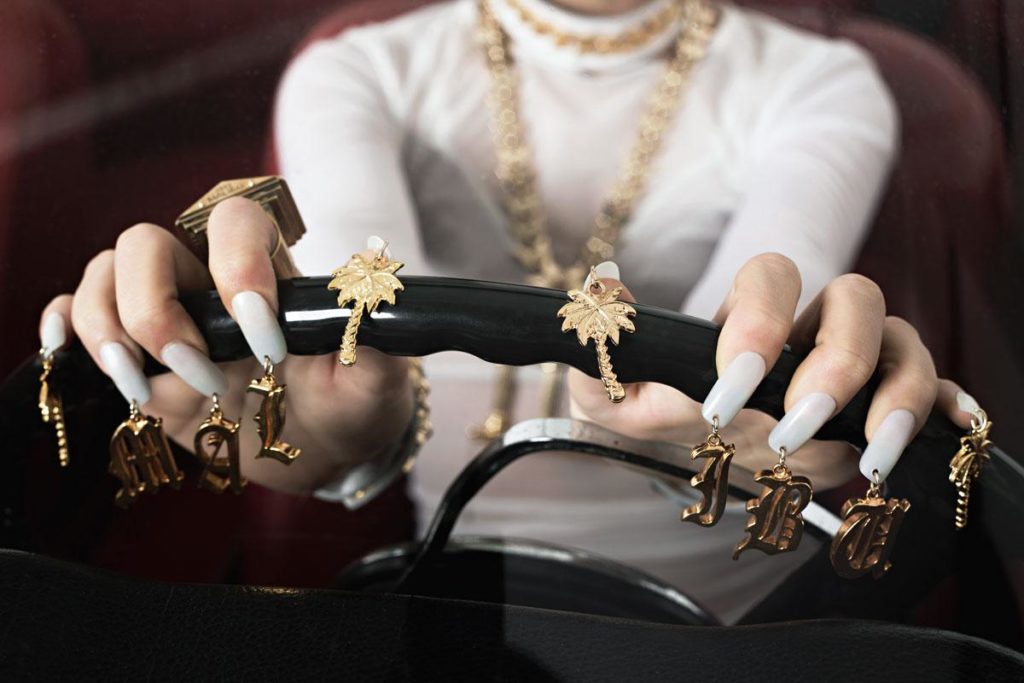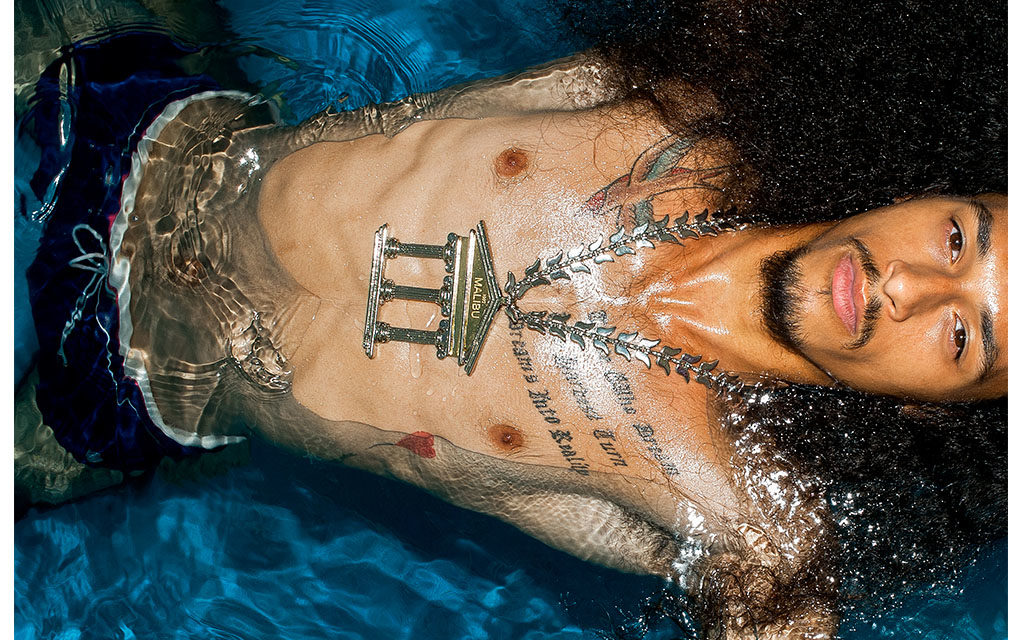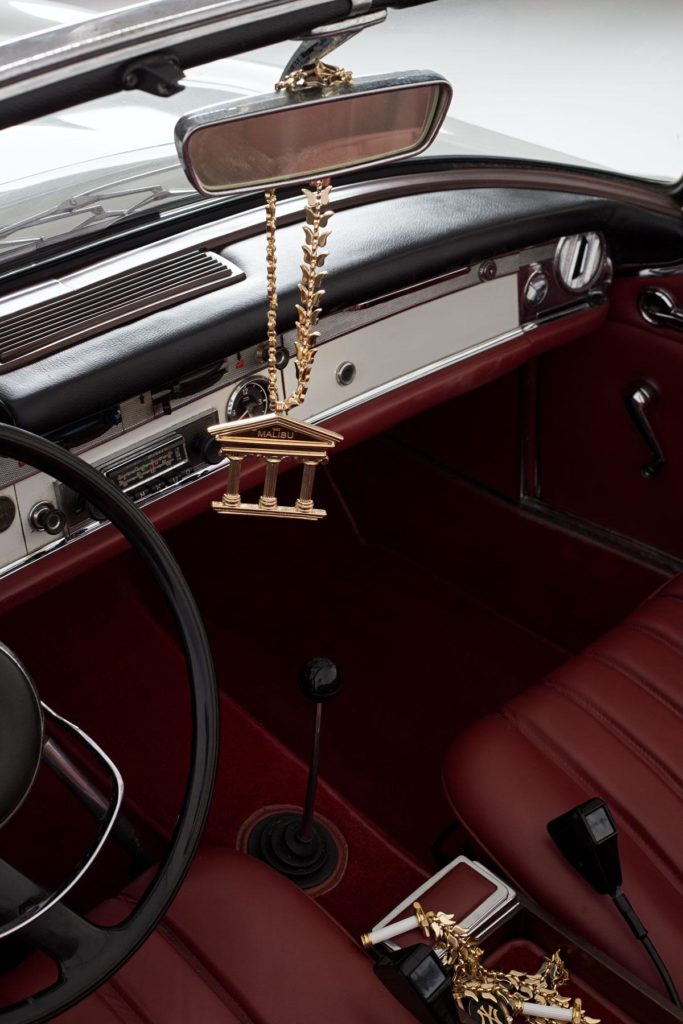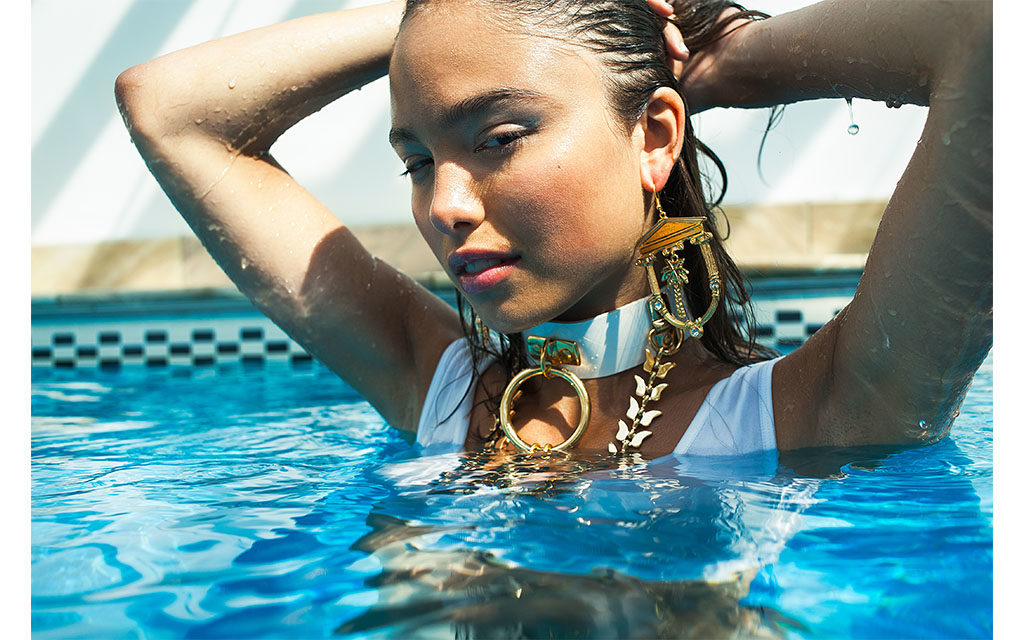If you ask Dorian Gray, founder of Malibu 1992, how he started his own fashion label four years ago you might learn that it was less for selling clothes than it was making videos. The Milan-based designer sketched his first jewelry collection — a Versace-sque potpourri of gold palms and gaudy bling — to advertise a DJ set at legendary disco-club Plastic where he was working as creative director at the time. Gray simply wanted to play with the clichés of product placement, founding no better way than by creating nonexistent, ostentatious merchandise and insidiously inserting it in his videos.

The video in question ends with the claim, “If you come to Plastic, I shoot you!” From pure fiction to blurred reality, the perfect Italian simulacrum was taking shape. The rest is history.
Iggy Azalea, Rihanna and Mykki Blanco are among those customers who have appreciated Malibu 1992 accessories, while Brooke Candy and Mademoiselle Yulia both gave testimonials in 2014. The following year the brand started producing clothing. First, there was the ‘Electronic Feudalism’ capsule collection, whose main features were interchangeable metal coats of arms applied on striped sweatshirts and trousers. Then it was ‘PETROL,’ an investigation into black gold aesthetics from the ecological disaster of the Gulf War to the hyper-capitalist development of Dubai. And now for institutional recognition: Camera Nazionale della Moda Italiana included Malibu 1992 in the official program of the Milan Menswear Fashion Week in January and June of this year, respectively.
In the meantime, we stopped for a chat with the man behind the label about luxury, appropriation and the evolution of subcultures.
**Parties, videos, music, art direction and, for a few years now, a fashion and jewelry brand. What is Malibu 1992 and who is behind it?

Malibu 1992: Malibu 1992 is a non-place where epochal changes happen. Here, the past resurfaces, mercilessly interfering with daily life and projecting itself in a performative dimension full of different languages and attitudes: from music production to branding, fashion design to video clips, marketing and luxury. The project is managed in a totally independent way by me and a bunch of friends who I know since many years. All together we work hard to let Malibu 1992 become a universally recognized entity. Although everyone in the team has specific positions, we all come from music and have 90s subcultures in our background.
**You’ve also worked in the field of fashion show soundtracks. Of course, remixing has a big role in both your FW and SS collections. Who or what is disguised there?
M’92: It’s inevitable that many names find a place in my collections. Apart from influencing my choices and even my lifestyle, they are personalities who have influenced the history of contemporary art. Their work and existence can help decoding an entire culture. For instance, Gregg Araki‘s teen trilogy — Totally Fucked Up, The Doom Generation, Nowhere — still is one of the greatest representations of juvenile inadequacy I’ve ever seen in cinema. These movies are 20 years old and they still speak to many people. Then the ad campaigns with Nadja Auermann shot by Helmut Newton for Blumarine in Monte Carlo, Keith Flint [of The Prodigy] in the video of ‘Firestarter,’ as much as Adamski in ‘Killer,’ they all converge under the pyramid of Cocoricò, the iconic Italian club with which I collaborated for my first show. I’m strongly attracted by these grandiose names and the branding strategies behind them.

**Talking about branding strategies, things have been mixing up lately. On the one hand, quite a number of luxury companies are appropriating outfits and sportswear which were traditionally associated with the working class, while on the other hand ostentation has been legitimized again. Where does Malibu 1992 place itself in this game of social commentary?
M’92: Personally, I’m an enthusiast of this freedom of expression. Fashion offers nowadays many opportunities, being a language in which many other grammars merge together. Luxury is not a taboo anymore, and it is being produced for a wider audience as compared to the past. I must say though, that this game of loans and appropriations always existed in the communities I joined.
Today, there is only more stuff to exchange and there are more places to share it. You can see the process very clearly at its beginning in some videos made by Swiss artist Sylvie Fleury in which contemporary art draws fully from fashion and videoclips. It is also the case of another Swiss artist, Pipilotti Rist, who performs Chris Isaak’s hit ‘Wicked Game’ in her ‘I’m a victim of this song.’
The original ‘Wicked Game’ videoclip is probably one of the greatest manifestos of what fashion meant in the 90s: supermodel Helena Christensen plays in it, it’s directed by legendary photographer Herb Ritts. These modes of exchange have nowadays become necessary marketing strategies, as for Louis Vuitton and Supreme; M.I.A. and Versace; Valentino and Jamie Reid; the anarchist who designed all of Sex Pistols’ memorable covers. Malibu 1992 places itself at the top of this mesmerizing chaos. We can now proudly say that we have contributed to creating it, after more than 10 years in the world of clubbing and now with fashion.

**What you have just described made me think that labels like ‘subculture,’ ‘alternative’ and ‘counterculture,’ which shaped a certain understanding of the world from the 70s to Generation X, now seem opaque. What meaning do these words have for you, are they in any way useful nowadays? The 90s seem to be a turning point in this sense.
M’92: Exactly. I think the Generation X subcultures born in the 90s evolved into something new for the first time. Take the emos for instance: while they were recognized as the last bastion of what was once called ‘alternative,’ they also will be remembered as the first movement to use social media before Millennials. I myself have roots in many subcultures since I was very young: Goth, Victorian, New New Romantic, Brit Pop, Indie, 60s, Beat, etcetera. I used to believe in them firmly and still appreciate those who persist in this purpose. Yet I’m too curious to stay anchored to the past. In 2017 there is only a big nameless basin where all different attitudes meet and change quickly: some subcultures only exist online, others immediately become pop, mass culture. The very thing I took from the 90s is my crepuscular nature.
**So, in the end, is Malibu 1992 a luxury company?
M’92: I like to define what I do as a digital degeneration of luxury. Malibu 1992 is something that started at the bottom, appropriating the stylistic features of money and finance without asking for permission, literally. We are a platform for virtual patronage, which doesn’t require investments. Malibu 1992 commissions itself aesthetic situations, where already known facts or objects transform into something new and luxurious.**
Malibu 1992 is a Milan-based designer and fashion collective.













